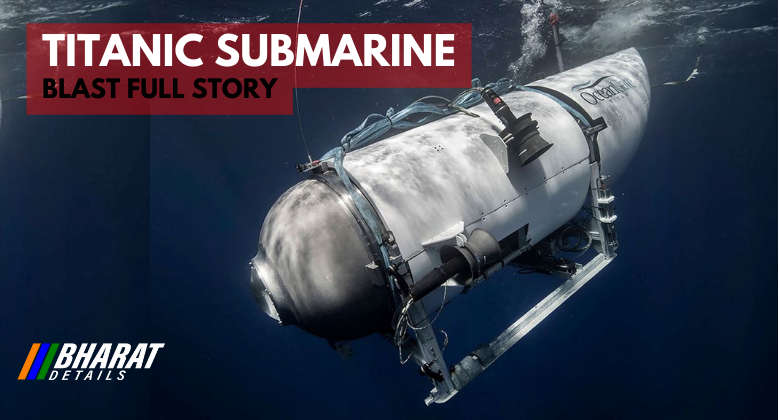Exploring the Titanic Submarine Blast: A Ground Report on the Special Story and Its Causes

- A submarine named "Titan" with five people inside, collapsed and broke apart near the spot where the Titanic sank. Sadly, everyone aboard lost their lives in the incident.
Recent news reports have brought to light a distressing incident involving the Titan submarine, which was being operated by OceanGate Expeditions. The submarine exploded in the Atlantic Ocean, following its departure on a mission to explore the remains of the Titanic near the Newfoundland coast on June 18. Tragically, the submersible lost contact just two hours after setting off. The ill-fated expedition included several notable individuals, such as a renowned Titanic expert, an explorer holding a world record, two members from one of Pakistan’s wealthiest families, and the CEO of the company. The US Coast Guard, along with deep-water experts from Canada, the UK, and France, initiated a search operation for the Titan submarine on Sunday, June 18, leading to a desperate multinational rescue effort. Sadly, the US Coast Guard confirmed yesterday that there were no survivors following the devastating implosion that occurred at great depths in the North Atlantic.
Contents
How much did Titan search cost?
Experts estimate that the extensive search operation for the missing Titan submersible will incur costs amounting to millions of dollars. The search effort involved various entities, including the US Coast Guard, the Canadian Coast Guard, the US Navy, as well as government and private organizations. The search area covered a vast expanse, stretching over thousands of miles, which is twice the size of Connecticut. Moreover, the search took place in extremely deep waters, reaching depths of around two and a half miles (4 kilometers).
Naval historian Norman Polmar emphasized that this search is unprecedented and unmatched in previous oceanic searches. The involvement of numerous nations and even for-profit businesses further distinguishes this operation from any other conducted in history.
According to the Government Accountability Office, operating the aircraft involved in the search incurred expenses in the range of tens of thousands of dollars per hour. Various aircraft types, including P-3 Orion turboprops, P-8 Poseidon jet subhunters, and C-130 Hercules, were utilized during the search efforts.
While certain organizations might seek repayment, it is important to note that federal law typically prevents the U.S. Coast Guard from collecting reimbursement for search and rescue operations. Attorney Stephen Koerting, who is representing the case, estimates that his fees alone will amount to millions of dollars.
Understanding Deep-Sea Implosions:
Deep-sea environments are known for their extreme conditions, characterized by immense water pressure at great depths. Submarines and other deep-sea vehicles are designed to withstand these pressures through robust structural integrity and careful engineering. However, the forces exerted at significant depths can still pose formidable challenges.
- Water Pressure:
One of the primary factors that may have led to the implosion of the Titanic submarine is the overwhelming water pressure at the depths it was operating. As the submarine descended further into the ocean, the pressure on its hull increased significantly. If the submarine’s construction or materials were compromised or if there were flaws in the design, the intense pressure could have caused the structure to give way, resulting in an implosion.
- Structural Weaknesses or Failures:
Another possibility is that the submarine experienced structural weaknesses or failures. Over time, continuous exposure to harsh underwater conditions, including saltwater corrosion and constant pressure changes, can weaken the integrity of the vessel. If there were pre-existing flaws or damage that went undetected, it could have contributed to the implosion.
- External Forces:
The occurrence of external forces impacting the submarine cannot be entirely ruled out. Unforeseen circumstances such as colliding with underwater objects, encountering powerful underwater currents, or suffering mechanical malfunctions could have put immense stress on the submarine’s structure. In extreme cases, these forces could overwhelm the vessel’s design limitations, leading to catastrophic failure.
Investigation and Lessons Learned:
Determining the precise cause of the Titanic submarine implosion requires a thorough investigation and analysis of available data, including the wreckage and any recorded information from the vessel’s systems. Experts in naval architecture, engineering, and underwater exploration will meticulously examine all possible factors and scenarios that might have led to the implosion.
Read more ⬇️
The tragic incident serves as a somber reminder of the inherent risks involved in deep-sea exploration. It highlights the need for robust safety protocols, meticulous inspections, and ongoing maintenance of underwater vehicles to ensure their structural integrity and the safety of those aboard.

